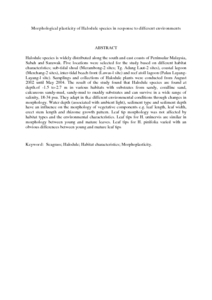Citation
Bujang, Japar Sidik and Ahmad Nazriz, Norhapizah and Zakaria, Muta Harah and Arshad, Aziz and Ogawa, Hisao
(2008)
Morphological plasticity of Halodule species in response to different environments.
Marine Research in Indonesia, 33 (1).
pp. 11-16.
ISSN 0079-0435
Abstract
Halodule species is widely distributed along the south and east coasts of Peninsular Malaysia, Sabah and Sarawak. Five locations were selected for the study based on different habitat characteristics; sub-tidal shoal (Merambong-2 sites; Tg. Adang Laut-2 sites), coastal lagoon (Merchang-2 sites), inter-tidal beach front (Lawas-l site) and reef atoll lagoon (Pulau Layang-Layang-l site). Samplings and collections of Halodule plants were conducted from August 2002 until May 2004. The result of the study found that Halodule species are found at depth.of -1.5 to-2.7 m in various habitats with substrates from sandy, coralline sand, calcareous sandy-mud, sandy-mud to muddy substrates and can survive in a wide range of salinity, 18-34 psu. They adapt in th,e different environmental conditions through changes in morphology. Water depth (associated with ambient light), sediment type and sediment depth have an influence on the morphology of vegetative components e.g. leaf length, leaf width, erect stem length and rhizome growth pattern. Leaf tip morphology was not affected by habitat types and the environmental characteristics. Leaf tips for H. uninervis are similar in morphology between young and mature leaves. Leaf tips for H. pinifolia varied with an obvious differences between young and mature leaf tips
Download File
![[img]](http://psasir.upm.edu.my/15735/1.hassmallThumbnailVersion/Morphological%20plasticity%20of%20Halodule%20species%20in%20response%20to%20different%20environments.pdf)  Preview |
|
PDF (Abstract)
Morphological plasticity of Halodule species in response to different environments.pdf
Download (85kB)
| Preview
|
|
Additional Metadata
Actions (login required)
 |
View Item |

